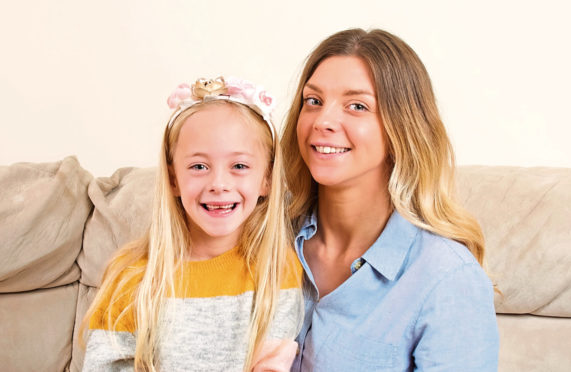
Millie, who turns seven this week, is an active little girl who loves football, horse riding and swimming.
But the girl, who was born at just 28 weeks and suffered a traumatic start in life, is also a loving child with a startlingly mature awareness of her twin sister Scarlett, who tragically died aged just one month.
“She knows about Scarlett. When we go to visit her grave, Millie is very sweet towards her and blows her kisses,” mum Emma Herbert says.
Sadly, Emma’s pregnancy was fraught with worry from the beginning. At her 16-week scan serious concerns were raised about the babies’ growth rate and heart irregularities.
“They said we shouldn’t even hold out any hope of meeting them. It was brutal,” Emma recalls.
With support from the twins’ father Dan Sinclair, Emma focused on being the healthiest she could be and tried to stay positive, even though doctors gave the babies only a 60% chance.
The babies were affected by a condition called intrauterine growth restriction which means babies can grow so slowly in the womb that they are at risk of health problems.
If the growth restriction is severe, the baby may have to be delivered, and seven months into Emma’s pregnancy, the decision was made to deliver the twins by caeserean section.
To Emma and Dan’s immense relief, both girls cried as soon as they were born. Scarlett was born first weighing just 1lb 6oz. Millie followed, weighing a tiny 1lb 4oz.
Both babies needed a ventilator to help them breathe. They were not yet ready for milk, so were given fluids by tube into their tiny veins.
The babies were too small and fragile to be held but Emma and Dan could place their hands over their daughters’ heads.
“Scarlett was so poorly that they didn’t want to move her at all but Millie seemed to be coming on in leaps and bounds, even though she was smaller,” Emma says.
“The team would always give us a couple of minutes to get settled, then update us on how the night had gone, especially focusing on the twins’ breathing. It was hard to follow what all the medical terms meant,” Dan says.
“But we could tell how well the girls were from how still they were, or how much they were moving, and whether they were in the high-dependency room, the low-dependency room or the acute room.”
Emma and Dan were encouraged to help care for their tiny twins and took every opportunity to take on practical tasks such as changing nappies and washing them.
Emma expressed milk for her babies which the hospital staff froze and stored. But while Millie was soon able to take tiny amounts, given to her by syringe down a tube, Scarlett wasn’t able to respond.
Scarlett also continued to need a great deal of support with her breathing and was cared for in the Neonatal Intensive Care Unit, while Millie became more stable and was supported in the High-Dependency room.
Sadly, after Scarlett was transferred to hospital in Bristol, her health deteriorated rapidly.
“She had problems with her breathing and her body was swollen,” Emma says. “By the time she was ready for surgery her stomach was purple.”
Scarlett had contracted nectrotising enterocolitis (NEC), a potentially deadly disease of the bowel that can strike shockingly quickly.
Tragically, it became clear that Scarlett could not survive and Emma and Dan faced the heartbreaking loss of their tiny daughter.
“They told us we could hold her until they switched life support off. We held her in our arms, on a cushion as she was so fragile. We held her head and her hands and said goodbye. When she was comfy, they turned the machine off,” Emma says.
More heartache was in store as Millie also contracted NEC and became very ill very quickly. Fortunately, a top paediatric surgeon took the decision to operate immediately, on the ward, rather than waiting to take Millie down to theatre.
“It was the worst wait ever,” Dan recalls. “We sat in a side room for 50 minutes and the eventual knock on the door was so scary.”
Thankfully, medics were positive, explaining that they had removed a small amount of Millie’s bowel, repaired it, and given her a stoma bag to manage her body’s waste.
Over the next few weeks, Emma stayed in hospital caring for Millie, while Dan came to join them after a full day working as a car sales manager.
Millie’s health improved and Emma and Dan were able to take her home after three and a half months.
Emma was anxious about taking Millie to baby groups because of the risk of infection but now mum and dad are overjoyed with her progress.
“Millie is so clever – she knows her phonics and can spell. Being at school now is really improving her confidence levels,” Emma says proudly.

Enjoy the convenience of having The Sunday Post delivered as a digital ePaper straight to your smartphone, tablet or computer.
Subscribe for only £5.49 a month and enjoy all the benefits of the printed paper as a digital replica.
Subscribe © Ben Rector
© Ben Rector